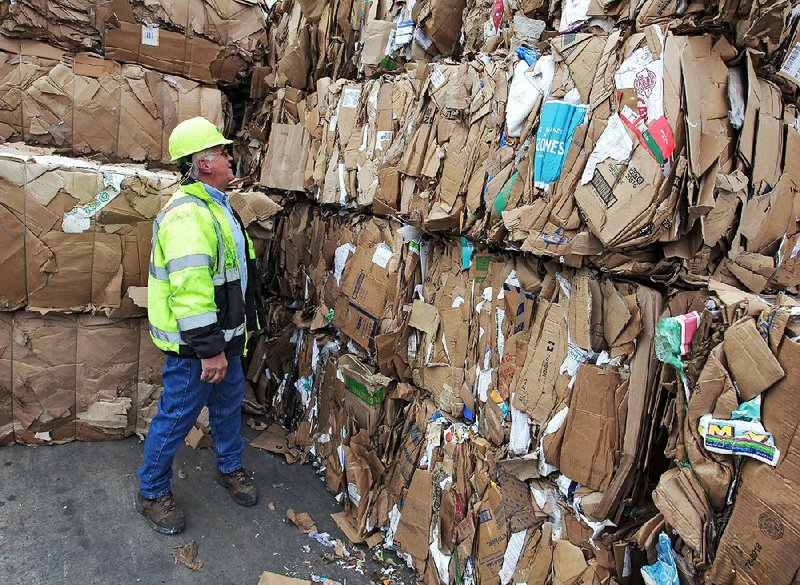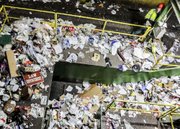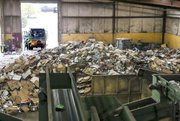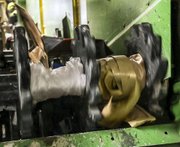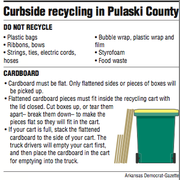Yessss! That thing you ordered from your favorite online retailer has finally arrived on your doorstep.
You scoop it up, bring it inside and set about liberating it from the cardboard box that has been its home.
Yeaaaaa! There it is, in all its glory, the wonderful item you just had to have and paid for with your hard-earned money. Oh, happy day.
Now, to discard the cardboard box before enjoying this new addition to your life.
You open the carport door, step outside and drop the cardboard box and its packaging plastic into the big green and yellow-topped Waste Management recycling cart, doing your part to save the planet from unnecessary waste.
Good for you but, if you're in Pulaski County, you're kinda doing it wrong. The box needs to be broken down and flattened before it gets shoved into the recycling cart.
"Cardboard can't be efficiently recycled if it's still a complete box," says Craig Douglass, executive director of the Regional Recycling & Waste Reduction District, which includes all of Pulaski County and is one of 18 solid waste management districts in the state. "It's most efficient to recycle when it is flat."
That's because flattened boxes and cardboard are easier to get through the gigantic "stream" of refuse that is sorted by machine and humans at the 40,000-square-foot Material Recovery Facility in
Little Rock. Flattened boxes are also usually not filled with pesky plastic wrappings or packaging peanuts.
"Boxes that aren't broken down, that's what jams it up sometimes," says Rusty Miller, the recovery facility's plant manager. Earlier, a box that hadn't been broken down briefly stopped the flow of the stream.
Miller is standing on a catwalk above the facility's floor over a section where cardboard is sorted across quickly rotating axles with spinning gear-like metal "stars" strategically placed to move the cardboard along. When the boxes are flat, they glide across the tops of the spinning axles and stars like a surfer on a wave.
"They just float across," Miller says above the din of the machinery, which sorts paper, cardboard, plastic, aluminum and other items through an almost Rube Goldberg-type process of conveyor belts, vacuums, blowers, computers, gravity and people power, eventually sorting as many items as possible into like items to be smushed together and cinched with wire in bales of paper, cardboard, plastic and aluminum. These bales, which can weigh up to 1,200 pounds, are then taken away to be remade into shiny, new things.
The facility is like a loud, smelly abattoir for recyclables, where, Miller says, about 100 tons of material are processed each day.
Along with offering up the occasional head-scratcher like body armor (more on that later), the recycling stream can also be a sort of barometer for modern shopping and marketing.
In Jacksonville, says Jim Oakley -- who is director of that city's public works -- recycling workers always notice an increase in plastic bottles and milk jugs during the summer. Why? That's when kids are home from school.
In his 25 years of work in recycling, Miller has seen plenty of changes that reflect the modern consumer.
"Newspapers have gotten smaller, and we don't get phone books like we used to," he says. "Look in your refrigerator. You see a lot of plastic bottles and jugs" where there were once glass containers.
Also, he says, retailers pushed for less packaging so more product could be squeezed onto shelves, so the cardboard boxes that cases of plastic water bottles once were sold in have given way to a plastic wrap.
And even the containers have changed.
"It's evolved," Miller says. "When we first started recycling plastic water bottles, the plastic was very thick, you could drive nails with them. Now they're so thin."
BOXING DAYS
It's no coincidence that the waste reduction district is focused on increasing customer awareness of the correct way to recycle cardboard.
"The forecast for this holiday season includes increases in online shopping and shipping," says Douglass. "That means more cardboard boxes and a greater opportunity to practice effective recycling, and to inform residential customers how to do recycling right."
The National Retail Federation predicts that online shopping this season will increase 15 percent over last year, while overall holiday buying is expected to increase by 4 percent. And, since 2009, boxed shipments delivered to customers at home have increased 65 percent.
Removing plastic, Styrofoam and other inserts and flattening the boxes before placing them in the carts is a big help, he says. Not enough room in the container? Most Pulaski County customers can lean excess cardboard on the side of the cart. Maumelle residents, whose recycling is picked up by the city and delivered to the Waste Management facility, are asked to place overflow cardboard beneath the recycling cart.
SOME CANS CAN'T
Across Arkansas, there are 73 curbside recycling programs and 199 drop-off recycling programs, says Kelly Robinson, public information officer with the Arkansas Department of Environmental Quality.
"Residents can contact their local sanitation department or their regional solid waste management district to learn more about recycling options in their area," she says.
"It takes me about a month to fill it up, so I put it out when it's full," says Chris Dimon on a bright fall morning as rows of green recycling carts await pickup in front of the homes of his North Little Rock neighborhood. He adds that he makes it a point to flatten the cardboard he recycles.
"I could always recycle more," he says. "Just taking out the newspapers, cans and plastic containers alone has reduced my trash by over 50 percent."
While Little Rock, North Little Rock and Sherwood residents have 64- or 96-gallon carts, in Jacksonville, where the city handles its own recycling, residents separate recyclables into three 12-gallon bins, one each for paper, for plastic, and for aluminum and other metal cans. Folded cardboard boxes are placed to the side, Oakley says.
"It needs to be broken down and no larger than 3 square feet," Oakley says of the cardboard. "Or, 24 hours a day, seven days a week, you can drop cardboard off at our location at 1300 Marshall Road."
All that properly flattened cardboard from Pulaski County will eventually be recycled into something new. Boxes that aren't flattened are put aside and end up in the landfill, says Douglass.
"You have to set them aside," he says, "because there's not the time, nor can the machinery separate [intact] boxes."
It's all in an effort to keep the amount of trash sent to landfills at a minimum.
"Part of our mission," Douglass says, "is to divert recyclable material from the landfill. The landfills we have in Pulaski County have a very long life, but logic only tells us that eventually landfills will fill up. We want to recycle what we can so it can be re-marketed and used to make new things out of old things."
Cardboard boxes, according to figures from the waste reduction district at flatcardboard.com, are the largest part of the waste stream and have a 75 percent to 90 percent recycle rate.
"Cardboard, because the primary material is fiber, can be used to make additional packaging, and it also can be used to make recyclable clothing like hospital gowns," Douglass says.
NO WIGS, PLEASE
Back at the recycling facility, Miller points out a problem that will need to be addressed.
A large plastic wrap has entangled one of the axles.
"The only way to get rid of it is to shut it down, climb in there and pull it out," Miller says.
It's part of life in the stream, where, despite eagle-eyed, quick-handed workers and a finely calibrated system sorting through the refuse, troublesome pieces can slip past.
"We're talking about sheets, wrappers, plastic bags, wigs," Miller says.
These are just a few of the items that shouldn't have even been in recycling containers in the first place.
At flatcardboard.com, residents are asked not to put plastic bags, strings, ties, electric cords, hoses, bubble wrap, plastic wrap and film, Styrofoam, food waste and yard waste in recycling containers.
Oil, electronics, clothing, construction debris and organic matter are also curbside recycling no-nos.
Along the catwalk at the Waste Management facility, Miller points to pieces of wood that had been pulled from the stream's steady flow and placed in a garbage can. Outside the building are clumps of concrete that workers pulled from the stream. There was also, ominously, a bullet-resistant vest that came in a few days earlier with a hole in the front.
"That shouldn't have been in there," Miller notes, dryly.
HomeStyle on 12/09/2017
